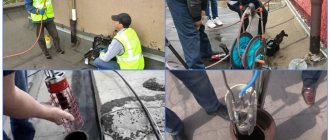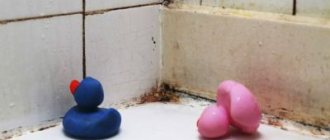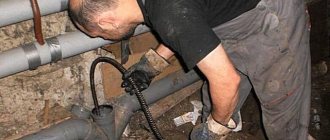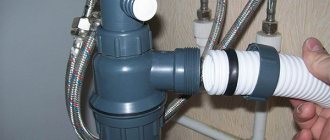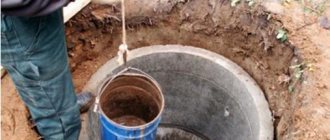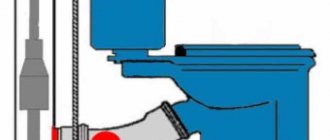Living in an apartment building, you have to use utilities, and they are paid. It is no secret that at least one apartment on the rise will turn out to be a malicious defaulter, to whom public utilities, after a long period of non-payment, take radical approaches. One such method is stubs. What it is and how to remove the plug from the sewer yourself will be discussed in this article.
Plug blocking the sewer
Purpose of the device
Plugs are a kind of valves that allow you to block the sewer hole connecting the common riser with the system of a specific apartment. This innovation is used in cases where utility workers cannot get into the apartment of defaulters in order to shut off the water supply. Therefore, workarounds are being undertaken.
By introducing special devices through the drain pipe leading to the attic space, shut-off valves are installed, supplied to the butt joint of a particular apartment. Such an overlap will prevent feces from going down the drain - waste will accumulate in front of the plug and eventually clog not only the toilet, but also the pipes that drain water from the sink and bathtub.
Drain shutoff option
How quickly this happens depends on the type of stub:
- a lattice-shaped ceiling will allow water to pass out, and only solid substances will accumulate;
- The solid valve closes the side hole into the sewer tightly.
The actions of installing the plugs themselves are not so difficult if they are performed by specialists, but they require maximum precision so that these actions do not harm innocent neighbors.
Legality of installing a sewer plug for debtors
It must be assumed that a sewer plug can turn into a real problem for the debtor. For the first couple of days, you will still be able to use the amenities, but in the following days it will be very difficult, since the entire drain will begin to rise from the barrier and eventually flow back into the apartment. Currently, solid or lattice sewer plugs are used.
For debtors, in fact, the type of device does not matter much.
However, with lattice plugs it will be a little easier to survive the sanctions of the service company. Such a device allows liquid waste to pass through and retains solid waste.
A solid plug will prevent all drains from escaping. The installation of plugs on sewer lines for debtors is carried out in compliance with a number of requirements.
How to install the valve
A sewer plug for debtors is installed either by a specially trained plumber, or employees of a company that practices this type of service are hired for this purpose. Carrying out work to block the sewer can be represented by the following algorithm:
- to begin with, we carefully study the sewer communication diagrams of the entire riser and the debtor apartment in particular;
- Next, precise calculations are made of the location of the drain hole from the apartment;
- Having climbed to the roof, the specialist lowers a manipulator into the pipe, on which a plug is attached, and using a monitor and LED, finds the required hole in the common sewer riser;
- Having reached the desired “fork”, the plug is inserted into the side hole of this apartment and fixed there.
All that remains is to pull the devices out of the pipe and wait until the debtor is ready to pay the bills. Only then will utility workers remove the plug from the sewer.
Inserting a plug into the sewer
But it is unlikely that the owner of the problem apartment will put up with this state of affairs - he can remove the plug from the sewer himself if he so desires. The main thing is to take measures that are not legally punishable.
How to use the toilet if you put a plug on the sewer
Therefore, the management organization does not have any problems with other residents. As practice shows, this is a truly effective measure in the fight against debtors, since it is simply impossible to live without sewerage.
Before installing plugs Of course, a sewer plug for debtors, the legality of which we have established, is an extreme measure. But if neither notifications nor short-term suspensions of public services produce results, management organizations have to use such a harsh method.
The application must be completed in two copies, one is registered, the second is kept.
If within two days after this the plug has not been removed, then you can safely go to court or the prosecutor’s office. Very important! To the question of whether it is legal for debtors to put plugs on sewer systems, the answer was unequivocal - “Yes!”, but not a single legal act or Resolution states that the debtor must pay for the work of blocking and unblocking sewer drains.
Legality of eliminating the problem
The actions of the utility services are quite legitimate, on the one hand, but the subsequent reaction of the apartment residents may have a legally justified argument. If you treat the installed valve as a normal sewer blockage, then removing this plug should not be punishable.
True, not everyone knows that you can remove the plug from the sewer with your own hands and are trying to find specialists who will do it. How much such a service costs, and what the hired employee will do, is a separate conversation.
Note! To avoid legal problems later, it is better to think about how to remove the plug from the sewer without leaving your own apartment and without attracting unnecessary witnesses.
Immediately after installing the plugs, you should not take any action - then you will not have anything to argue with in the event that utility companies make claims. You will have to wait for the first signs of clogged drains and begin to use available means to remove the plug as a normal nuisance.
Removing the plug from the sewer yourself with video
They differ in different parameters, resistance to high temperatures and remote installation.
The valves completely seal the pipes and prevent the entry of debris, water and dirt.
They serve to protect pipes from mechanical damage.
With our help, you can remove the plug from the sewer at a reasonable price, without paying off the debt! Removing any plugs from all types of sewers installed by collectors, management companies and homeowners' associations. We work in all cities with a population of 300 thousand or more.
people: Moscow, St. Petersburg, Kazan, UFA, Nizhny Novgorod, Yekaterinburg, Perm, Orenburg, Samara, Novosibirsk, Tyumen, Chelyabinsk, Omsk, Krasnodar, Rostov-on-Don, Volgograd, Voronezh and many others.
Moscow, St. Petersburg, Novosibirsk, Yekaterinburg, Nizhny Novgorod, Kazan, Samara, Omsk, Chelyabinsk, Rostov-on-Don, Ufa, Volgograd, Perm, Krasnoyarsk, Voronezh, Saratov, Krasnodar, Tolyatti, Barnaul, Izhevsk, Ulyanovsk, Vladivostok , Yaroslavl, Irkutsk, Tyumen, Makhachkala, Khabarovsk, Orenburg, Novokuznetsk, Kemerovo, Ryazan, Tomsk, Astrakhan, Penza, Naberezhnye Chelny, Lipetsk, Tula, Cheboksary, Kaliningrad, Bryansk, Kursk, Ivanovo, Magnitogorsk, Ulan-Ude, Tver, Stavropol, Simferopol, Nizhny Tagil, Belgorod, Arkhangelsk, Vladimir, Sevastopol, Sochi, Kurgan, Smolensk, Kaluga, Chita, Orel, Volzhsky, Cherepovets, Vladikavkaz, Murmansk, Surgut, Vologda, Saransk, Tambov, Sterlitamak, Grozny, Yakutsk, Kostroma , Komsomolsk-on-Amur, Petrozavodsk, Taganrog, Nizhnevartovsk, Yoshkar-Ola, Bratsk, Novorossiysk, Dzerzhinsk, Shakhty, Nalchik, Orsk, Syktyvkar, Nizhnekamsk, Angarsk, Stary Oskol, Veliky Novgorod, Balashikha, Prokopyevsk, Khimki, Pskov, Biysk , Engels, Rybinsk, Balakovo, Severodvinsk, Armavir, Podolsk, Korolev, Yuzhno-Sakhalinsk, Petropavlovsk-Kamchatsky, Syzran, Norilsk, Zlatoust, Kamensk-Uralsky, Mytishchi, Lyubertsy, Volgodonsk, Novocherkassk, Abakan, Nakhodka, Ussuriysk, Berezniki, Salavat Elektrostal, Railway, Miass, Pervouralsk, Rubtsovsk, Almetyevsk, Kovrov, Kolomna, Kerch, Maykop, Pyatigorsk, Odintsovo, Kopeisk, Khasavyurt, Novomoskovsk, Kislomoskovsk, Serpukhov, Novocheboksarsk, Nefteyugansk, Dimitrovgrad, Neftekamsk, Circassian, Orekhovo-Zuevo, Derbent. , Kamyshin, Nevinnomyssk, Krasnogorsk, Murom, Bataysk, Novoshakhtinsk, Sergiev Posad, Noyabrsk, Shchelkovo, Kyzyl, Oktyabrsky, Achinsk, Seversk, Novokuybyshevsk, Yelets, Evpatoria, Arzamas, Obninsk, Novy Urengoy, Kaspiysk, Elista, Pushkino, Zhukovsky, Artem , Mezhdurechensk, Leninsk-Kuznetsky, Sarapul, Essentuki, Votkinsk, Noginsk, Tobolsk, Ukhta, Serov, Berdsk, Velikiye Luki, Michurinsk, Kiselevsk, Novotroitsk, Zelenodolsk, Solikamsk, Ramenskoye, Domodedovo, Magadan, Glazov, Kamensk-Shakhtinsky, Kansk, Nazran, Azov, Alexandrov, Aleksin, Anapa, Anzhero-Sudzhensk, Apatity, Arsenyev, Asbest, Balakhna, Balashov, Belebey, Belovo, Belogorsk, Beloretsk, Belorechensk, Birobidzhan, Bor, Borisoglebsk, Borovichi, Bugulma, Buguruslan, Budennovsk, Buzuluk, Buinaksk, Verkhnyaya Pyshma, Vidnoye, Volzhsk, Volsk, Vorkuta, Voskresensk, Vsevolozhsk, Vyborg, Vyksa, Vyshny Volochyok, Vyazma, Gatchina, Gelendzhik, Georgievsk, Gorno-Altaisk, Gubkin, Gukovo, Gus-Khrustalny, Dmitrov, Dolgoprudny, Donetsk, Donskoy, Dubna, Egoryevsk, Yeisk, Elabuga, Zheleznogorsk, Zhigulevsk, Zarechny, Zelenogorsk, Ivanteevka, Izberbash, Iskitim, Ishim, Ishimbay, Kineshma, Kirishi, Kirovo-Chepetsk, Klin, Klintsy, Kogalym, Kotlas, Krasnokamensk, Krasnokamsk, Krasnoturinsk, Krasnoufimsk, Kropotkin, Krymsk, Kstovo, Kuznetsk, Kumertau, Kungur, Labinsk, Leninogorsk, Lesnoy, Lesosibik, Livny, Liski, Lobnya, Lysva, Lytkarino, Meleuz, Mineralnye Vody, Minusinsk, Mikhailovka, Nazarovo, Naro-Fominsk, Neryungri, Novoaltaysk , Novouralsk, Nyagan, Pavlovo-Pavlovsky, Posad-Polevskoy, Prokhladny, Revda, Reutov, Rzhev, Roslavl, Rossosh, Salsk, Sarov, Svobodny, Severomorsk, Sibay, Slavyansk-on-Kuban, Solnechnogorsk, Sosnovy Bor, Stupino, Timashevsk, Tikhvin, Tikhoretsk, Troitsk, Tuapse, Tuymazy, Uzlovaya, Usol-Sibirskoye, Ust-Ilimsk, Feodosia, Fryazino, Khanty-Mansiysk, Tchaikovsky, Chapaevsk, Cheremkhovo, Chernogorsk, Chekhov, Chistopol, Shadrinsk, Shuya, Shchekino, Yurga, Yalta.
How to remove the valve
The plugs that block the sewer can be removed using the simplest, already tested methods: using a plunger and a metal cable, since there is no mechanical fastening on the shut-off valve (it is fixed pneumatically).
Plunger to the rescue
In every apartment there is this simple device called a plunger - it is used to clear blockages in the drain of a bathtub or shower stall, in the sink and toilet. So the actions of the residents will be completely legal. But you shouldn’t do anything blindly—you need to pull out the plug wisely:
- first, tap the pipeline, determining exactly where the problem is located; a dull sound will indicate it;
- then they look at which plumbing fixture is closest to the location of the obstacle;
- This device is filled with water until it stops leaking through the grate and remains in the drain.
Plunger in action
Now they take a plunger and perform the usual actions, as a result of which, under pressure, the plug will pop out of the side hole into the common sewer riser.
Using a rope
A plunger is not always effective, so the second option for removing the plug is to resort to using a plumbing cable. It has a special bushing at one end and a handle for rotation at the other.
Important! When purchasing a cable, you should first of all pay attention to its elasticity and strength.
To resolve the problem, follow the following algorithm:
- just in case, turn off the water in the apartment;
- Having removed the toilet, insert the cable into the resulting hole and begin to perform rotational and translational movements, directing the sleeve towards the plug;
- Having reached the place of the blockage, you will have to make an effort to push the valve into the sewer.
At the end of the sleeve there is a special hook that can be used to pick up the plug and pull it through the pipe into the room. This option is preferable, since a plug that goes into a common riser can block it (and then all the neighbors will suffer).
Removing the plug with a cable
When using the cable, you need to pay attention to some points:
- The cable should only be rotated clockwise, since movements in the opposite direction will lead to its shaft unraveling;
- after removing the plug, it is necessary to flush the sewer pipe (with the toilet in place); in this case, only hot water is used, the pressure of which should increase gradually;
- if the cable gets stuck in the pipe, it is pulled out without haste, slowly rotating it left and right.
Kinds
The plugs that are installed on sewer pipes can be rubber, metal, plastic or metal-plastic. The material of the device must match the material of the section of pipe that needs to be blocked. Therefore, in cast iron pipes, metal products are used, and in plastic pipes, PVC is used.
Depending on their purpose, valves are divided into permanent and temporary.
Permanent shut-off devices are part of the highways and cut into the networks at the time they are laid. They provide the possibility of subsequently connecting new areas to the system or dismantling old drains.
The permanent plug looks like a cap made of the same material as the main pipe. It can be PVC or more durable types of plastic. PVC plugs are inexpensive and durable, but they are not reliable, so they are used mainly for indoor work.
For laying underground networks, stronger plastic models are used. Their installation is not difficult, since it is done manually and only requires additional sealing of the cracks.
Temporary closures are needed for a short period of time in the event of an accident, repair or dealing with defaulters.
Depending on the design, inflatable and mechanical plugs are distinguished.
Inflatables are a rubber ball with spikes connected to a hose. It is placed in a suitable place in the pipe and air is supplied, due to which the ball inflates and does not allow waste water to flow. If such a plug is used against the debtor, it can be easily removed by him.
Mechanical or cylindrical products have a more complex structure.
They need installation aids (camera, hose, manipulator). They are also made of metal, plastic, they can have a rubberized surface or with protection from possible damage.
Some varieties do not completely block the drain, but have small-diameter holes or a mesh that allows water to pass through but prevents the drainage of larger particles.
Popular
They are not ready for winter: private management companies have accumulated debts for heating and are abandoning their homes. There are four such cases in Moscow: building managers owe almost one and a half billion rubles and want to go bankrupt. Suppliers are threatening to turn off hot water in problem homes.
In St. Petersburg, the fight against the placement of air conditioners on the facades of houses has intensified, which requires approval. Anonymous complainants take advantage of this - they bombard the city electronic portal with appeals. Formally, they are right, and owners of air conditioners have no chance of legalizing the installation of equipment.
“We are responsible for our property”
SHOTA GORGADZE: “If I, being a 95-year-old elderly and honored person, put a pot of flowers on the windowsill - simply because I think it’s beautiful; I started to experience dementia, and so, you know, I think that nothing bad will happen, but it will fall on someone’s head, who will be to blame? “Alas and ah, if a person is capable, if he is not limited in his legal capacity, then he will be to blame, and he will bear responsibility, no matter how sad it is for us to state this.”
